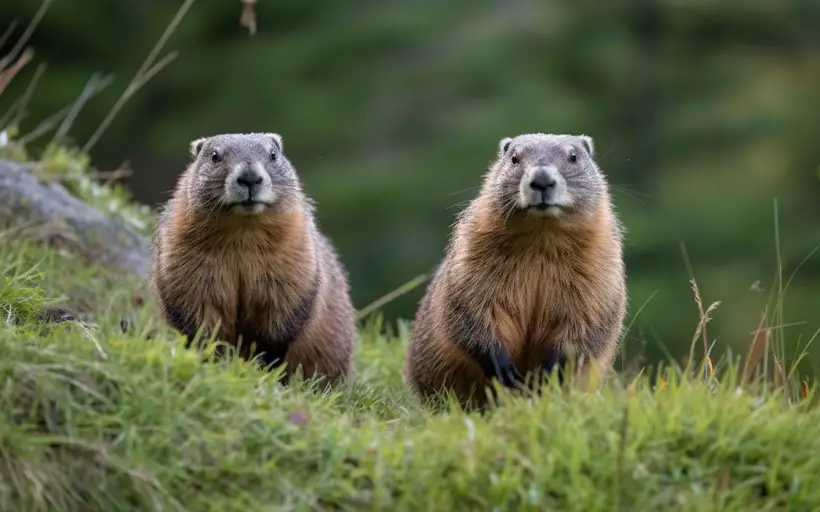Do Marmots Bite? Understanding Marmot Behavior and Potential Risks to Humans
Marmots are giant ground squirrels or groundhogs found in the mountains of the Northern Hemisphere: meadows, rocky slopes, and talus fields.
Hikers in hilly areas where marmots are common should learn about marmot risks. The question arises- Do Marmots Bite? Yes, Cute as marmots may look, they have the potential of becoming violent and even bite people.
Before you go hiking or camping, read this article to learn about marmots. It includes their potential biting behavior towards humans, whether or not they are aggressive, and how to be safe around them.
Marmot Biting Behavior
Marmots are not usually aggressive but may bite if you wake them up while they are sleeping or eating as they might feel threatened.
Here is a video that tells the secrets of Marmot hibernation.
How Marmot Behavior Changes with Seasons?
Here’s how Marmot biting behavior changes with seasons:
- Mating Season: In late spring or early summer, male marmots might become more aggressive and territorial. Males competing for females may bite.
- Pre-hibernation Season: Marmots may guard their burrows and food supplies in late summer and early autumn. If the marmot feels threatened by a predator or person during this time, it may bite.
- Winter Hibernation: Marmots do not bite during winter hibernation because they are dormant and not aggressively protecting their territory or food supplies.
- Spring Emergence: Due to hunger and the urge to reestablish their territory, marmots may be more agitated and defensive after hibernation.

Marmot Aggression and Potential Triggers
Marmots don’t fight. Nonetheless, they may be hostile to defend. Possible marmot aggressiveness triggers:
- Protection of territory: Marmots are aware of Territoriality. They protect their home and nearby regions from people and other animals. If threatened, they may turn violent.
- Protection of young: Female marmots vigorously guard their young against predators and other hazards. A mother may attack if you go too near to her infants.
- Food competition: Marmots eat plants. Marmots may fight for food if it’s limited.
- Provocation: Marmots are wild creatures, so don’t provoke them. They may attack in self-defense if threatened. Give them room and watch from afar.
Potential Risks of Marmot Bites
Are marmots aggressive? No, Marmots species are shy and avoid eye contact. When they feel threatened, they can bite and cause serious hurt.

Marmot Bites and Other Possible Injury
A bite from rodents like marmots can hurt, and it’s not uncommon for there to be some
- Swelling
- Redness
- Bruising at the bite site
When marmots bite, they can cause serious damage to the victim’s tissues. Marmot attack can cause serious complications such as
- infection
- scarring, and
- nerve damage in the worst-case scenarios
Disease Transmission from Marmot Bites

Some of the potential diseases that can be transmitted through marmot bites include:
- Plague
- Hantavirus
- Tularemia
- Rabies
How and Why Marmots May Bite Humans

Marmots may be dangerous to people for several reasons.
- Self-Defense– Humans may be seen as a danger by territorial marmots. A marmot may bite in self-defense if approached too close.
- Safety of their Children- If their young are endangered, marmots may attack. The adult marmot may bite if a person enters its cave or burrow and touches its young.
- Human Interaction- Marmots are wild creatures, not pets. Humans may unwittingly irritate marmots by getting too near, moving suddenly, feeding, or touching marmots.
- Disease/Parasite Transmission– Marmot bites spread illnesses and parasites. If it’s unwell, a marmot may bite a person, potentially infecting them.
How to Prevent Marmot Bites?

Some advice on how to avoid marmot bites and ensure hiking safety:
Keep a safe distance
It is best to keep your distance from marmots, especially while they are in their native environment. Don’t try to make any communication, touch them, or try to feed them.
Do not provoke them
Don’t bother marmots by throwing anything at them or trying to startle them. They may become aggressive as a result of being provoked or feeling threatened.
Keep your food secure
Marmots have a strong desire for and will persist in obtaining food. Don’t leave any food uncovered.
What To Do If Bitten By a Marmot
Here is what you should do if a marmot bites you:
- Clean the wound
- Apply first aid
- Monitor for signs of infection
- Seek medical attention
Marmot Safety Tips
Marmot safety precautions for hikers and travelers include keeping a reasonable distance, not trying to feed them, safeguarding food, and observing for signs of aggressive behavior.

Identify marmot behavior aggression cues
Marmot behavior is like any other mammal behavior towards humans and might be aggressive:
- Biting: If a marmot bites at clothes or gear, or attempts to bite a human, it indicates hostility.
- Tail Straightening: When a marmot gets triggered, it could flatten its tail against its back, signifying that it is preparing to fight itself.
- Loud vocalization: If they generate loud and aggressive vocal sounds including chirps, whistles, and barks, it is better to stay your distance.
- Starring: Marmots may look at you and track your movements, suggesting they are watching you.
- Charging: If marmots charge toward you, this conduct indicates that they feel endangered and are willing to defend themselves.
Maintain Safe Distance
It’s best practice to keep at least 50 feet of distance from marmots and other animals during wildlife photography or hiking. This space between you and the animals ensures wildlife safety and reduces Marmot habitat risks.
How You Should Behave Around Them

Listed below are some things to keep in mind if you happen to come across any marmots:
- If you see a marmot, don’t get near it or touch it. Keep your distance
- Don’t give the marmots anything to eat
- As it might attract marmots due to their acute sense of smell, always store food and fragrant objects in a safe, out-of-reach location
- If a marmot displays aggressive behavior, such as biting or charging, back away carefully
Reporting Concerns
Lastly, notify wildlife management agencies, park rangers, or wildlife management organizations if you see any unusual marmot or other animal activity. The staff there can provide tips on monitoring marmots without being hurt and preserving wildlife habitats.
If you’re curious about the behavior of marmots, you might find our articles on marmots climbing trees and marmots swimming interesting. While marmots are known for their burrowing abilities, they are also skilled climbers and can often be seen scaling trees in search of food or a safe place to rest. Our article on marmots climbing trees provides a detailed look at this behavior and why they do it. Additionally, marmots are strong swimmers and can even hold their breath for several minutes underwater. You can learn more about this in our article on marmots swimming.FAQs
Here are a few FAQs about this issue.
Q: What diseases can be transmitted by marmots?
Diseases including plague, tularemia, and leptospirosis might be spread by marmots.
Q: Can marmot bites be deadly?
Yes. While marmot bites are rare, an infected bite may be fatal if left untreated. If you were bitten by a marmot, consult a doctor right away.
Q: Are marmot bites common?
No. Bites from marmots are unusual since these animals aren’t hostile to us and often try to avoid any kind of interaction with us.
Conclusion
To conclude, while marmots often avoid conflict with people, they may resort to biting if they feel threatened or trapped. Precautions, keeping a safe distance, and not feeding or handling wild animals are necessary.
It would be useful to learn more about the effects of human activities on marmots’ biting behavior and their habitats. This is the best method for engaging with animals.
In light of this, we should encourage future generations to continue appreciating these natural treasures. We can work to engage in more moral and ethical practices that promote healthy ecosystems.




